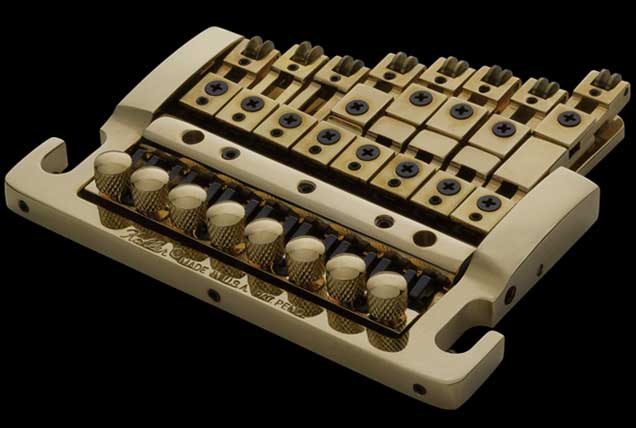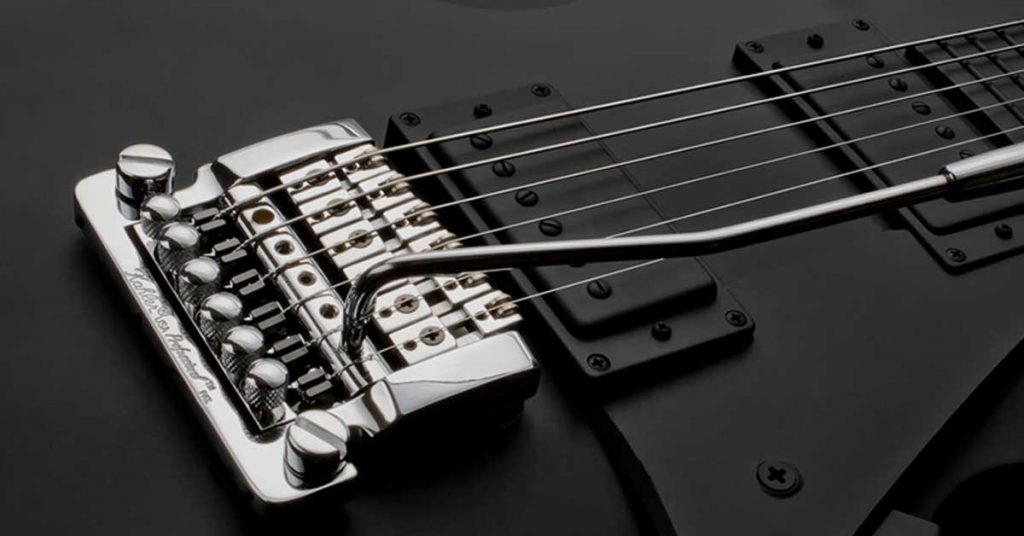Floyd Rose is pretty much the standard bridge system in the metal genre, and for good reason – it’s locking design that doesn’t allow the strings to go out of tune was revolutionary when it came out. And to this day, it’s still an excellent choice – but it’s not without its issues. Some people find the whole system to be entirely too complex to set up and maintain, particularly when it comes to changing strings.
Others, like myself, find that the feel isn’t as comfortable as the bridges they’ve previously grown used to – I rest my hand at the back when palm muting, and the saddles on the Floyd Rose were annoying to me. Before you write them off though, take into account that the locking nuts are permanently radiused. That can cause issues if you’re installing it on a guitar with a different fretboard radius, that’s definitely something people should keep in mind.
Branches on the Tremolo Tree
We can divide the bridges into four unique categories:
- Bigsby Vibratos
- Synchronized Tremolo
- Floating Bridge
- Cam-driven Bridge
Each tremolo style relies on different design principles and mechanics to achieve similar pitch bending effects, and each comes with its own set of pluses and quirks. But right now, we’re just looking for some direct alternatives for the Floyd Rose locking bridge system – so here are the top three:
Kahler Tremolo System
The Kahler Tremolo is the most popular alternative to Floyd Rose bridges because it has a double-locking feature (when combined with their locking nuts) that does not allow the strings to go out of tune, and can perform the same extreme pitch bends that the Floyd Rose is known for.
They offer locking nuts in different radius sizes – 10“, 12“, 15“, 17“. The locking nut is really an option though, as their bridges can be used without them and retain the guitars tuning quite well (as long as you don’t go for any extreme divebombs).

Their bridges are also offered with multiple mounting designs: flat mount, stud mount, or fixed. None of these require any extensive routing to install – unlike the Floyd Rose, which requires a large cavity in the back. Kahler has also gone the extra mile to accommodate more modern guitar designs, offering bridges for 7, 8, 9, and even 10 string guitars. They also make a bridge specifically for multi-scale instruments.
One of the main detractors of the Kahler tremolo system is that it doesn’t have great sustain in comparison to the Floyd Rose. This is due to the cam/roller design as opposed to the fulcrum you find in a Floyd Rose. But this is something that could be seen as a sacrifice, since the roller design allows for less modification and a much easier setup process.
Steinberger TransTrem Bridge
Steinberger’s TransTrem system first came out in the 80’s, and its one of the few tremolos that sought to offer more than Floyd Rose, rather than simply matching them. As suggested by the name, Stenberger’s bridge was built around the concept of allowing the player to transpose their guitar’s tuning entirely with ease. You could raise or lower the pitch of all the strings at once, locking them into preset positions.
The setup process isn’t any easier than a Floyd Rose, unfortunately, but in terms of pure function, the TransTrem’s complex design was way ahead of its time. The engineering made certain the individual strings’ pitches would not affect each other.
Although the company was bought by Gibson and the factory shut its doors for a while, they released a new generation of the TransTrem bridge in 2008, as well as a guitar design of their own: the ZT-3 Custom.
PRS Tremolo
While this option doesn’t offer as much range in pitch bending as the Floyd Rose, it most certainly is a contender. Paul Reed Smith and engineer John Mann had their original design patented in the 80’s and it’s gone through many generations and upgrades since, coming as a standard feature on many of their guitar models. It’s said to be one of the most stable floating bridges available, in spite of having a non-locking design.
The latest models have been adjusted to maximize the amount of vibrational energy being transferred from the string to the guitar’s body, giving an impressive amount of sustain.
MannMade Tremolos
As mentioned above, John Mann co-designed the original PRS tremolo system (in fact, first generation of PRS tremolos are known as “John Mann bridges”). John is still manufacturing various bridges and tremolos available for purchase here. Many of his designs are designed to be drop-in replacements for PRS, Fender, and other models – very handy when it comes to tremolo systems.
The MannMade tremolos come in a range of finishes, which is very handy if you’re looking for a more specific aesthetic outside of the standard silver/gold/black options you tend to have with most brands.
Original Patents and Designs for PRS, Kahler, and Steinberger
Where to buy tremolos & floating bridges
The three bridges listed above were made to compete with Floyd Rose directly, but they’re unfortunately on short hand these days. There’s either limited availability, or they’re only available on their respective guitar brand. When Amazon fails, websites like Allparts.com offer quite a few options and off-brand variations, so it’s worth checking them out.
Why not Floyd Rose?
If you’re considering installing a tremolo bridge system on your guitar, for whatever reason, there’s plenty of options. Sometimes having a Floyd Rose floating bridge system installed on your guitar when you’re only wanting to bend a chord a little bit every once in a while is complete overkill.
Double locking systems can be extremely frustrating as well – many people never learn how to properly setup a Floyd Rose system and never get the intended experience (remember: spring tension = string tension).
If there’s a fly buzzing around your head, you’ll probably reach for a fly swatter instead of a machine gun. That’s usually when something like a Bigsby or a Fender-style floating bridge would be a better choice.
It’s also worth noting that the bridge design can affect your guitar’s sustain (and overall tone in some cases). An example A/B test can be done when you remove the springs from a standard Stratocaster bridge, fixing the block. Many people have suggested that the springs themselves are responsible for the added sustain that Stratocasters are known for.
Just how many different vibrato options are there?
There’s a ton of other floating bridges and tremolo systems out there that are based on Fender and Bigsby designs that won’t listing here because they’re not really made to compete directly with Floyd Rose systems. But if anyone wants to look into some other options, here’s a few names to get you started:
Stetsbar Tremolo, Wilkinson VSVG 6-Point, Callaham 6-Point Vintage Trem, Hipshot 2-Point Roller Bearing, Strandberg EGS Tremolo, Trem King, Schaller 3801, Mosrite Vibrato – it’s a long list.
If you think there’s another bridge system that should be listed here, feel free to let us know!
And here’s a humorous poster for the Washburn Wonderbar, perhaps the worst tremolo system ever devised:
